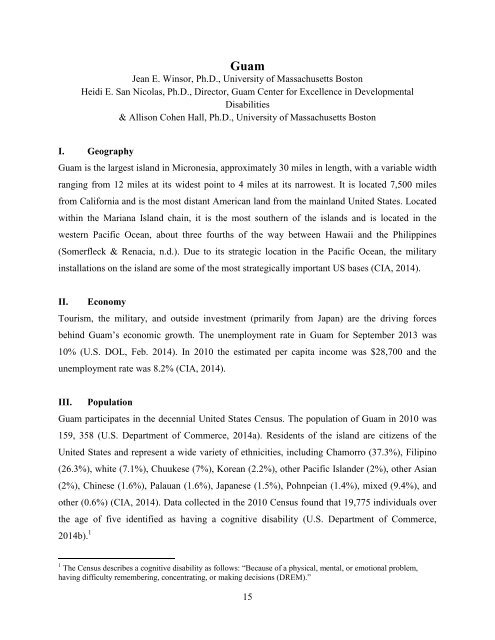Combined-Territories
Combined-Territories
Combined-Territories
You also want an ePaper? Increase the reach of your titles
YUMPU automatically turns print PDFs into web optimized ePapers that Google loves.
Guam<br />
Jean E. Winsor, Ph.D., University of Massachusetts Boston<br />
Heidi E. San Nicolas, Ph.D., Director, Guam Center for Excellence in Developmental<br />
Disabilities<br />
& Allison Cohen Hall, Ph.D., University of Massachusetts Boston<br />
I. Geography<br />
Guam is the largest island in Micronesia, approximately 30 miles in length, with a variable width<br />
ranging from 12 miles at its widest point to 4 miles at its narrowest. It is located 7,500 miles<br />
from California and is the most distant American land from the mainland United States. Located<br />
within the Mariana Island chain, it is the most southern of the islands and is located in the<br />
western Pacific Ocean, about three fourths of the way between Hawaii and the Philippines<br />
(Somerfleck & Renacia, n.d.). Due to its strategic location in the Pacific Ocean, the military<br />
installations on the island are some of the most strategically important US bases (CIA, 2014).<br />
II. Economy<br />
Tourism, the military, and outside investment (primarily from Japan) are the driving forces<br />
behind Guam’s economic growth. The unemployment rate in Guam for September 2013 was<br />
10% (U.S. DOL, Feb. 2014). In 2010 the estimated per capita income was $28,700 and the<br />
unemployment rate was 8.2% (CIA, 2014).<br />
III. Population<br />
Guam participates in the decennial United States Census. The population of Guam in 2010 was<br />
159, 358 (U.S. Department of Commerce, 2014a). Residents of the island are citizens of the<br />
United States and represent a wide variety of ethnicities, including Chamorro (37.3%), Filipino<br />
(26.3%), white (7.1%), Chuukese (7%), Korean (2.2%), other Pacific Islander (2%), other Asian<br />
(2%), Chinese (1.6%), Palauan (1.6%), Japanese (1.5%), Pohnpeian (1.4%), mixed (9.4%), and<br />
other (0.6%) (CIA, 2014). Data collected in the 2010 Census found that 19,775 individuals over<br />
the age of five identified as having a cognitive disability (U.S. Department of Commerce,<br />
2014b). 1<br />
1 The Census describes a cognitive disability as follows: “Because of a physical, mental, or emotional problem,<br />
having difficulty remembering, concentrating, or making decisions (DREM).”<br />
15



